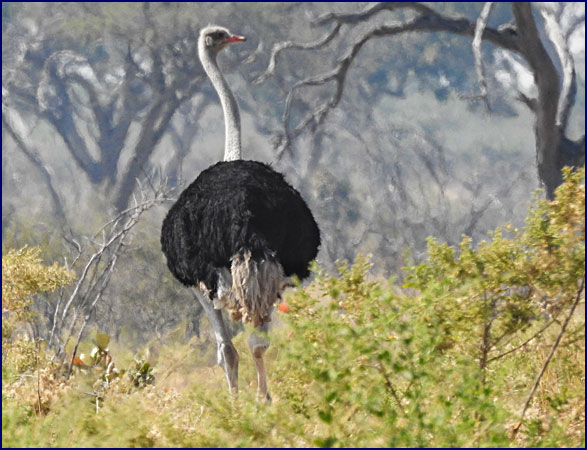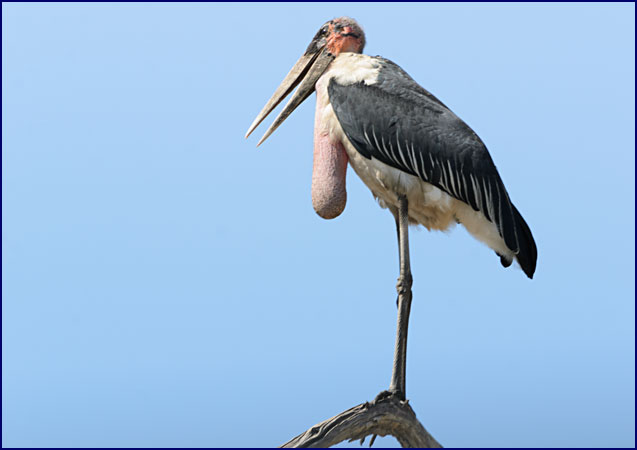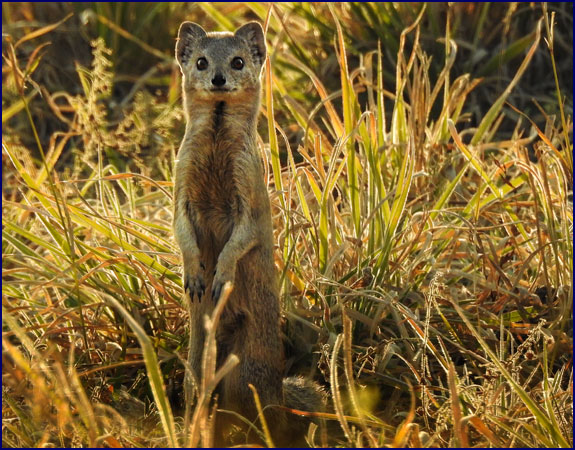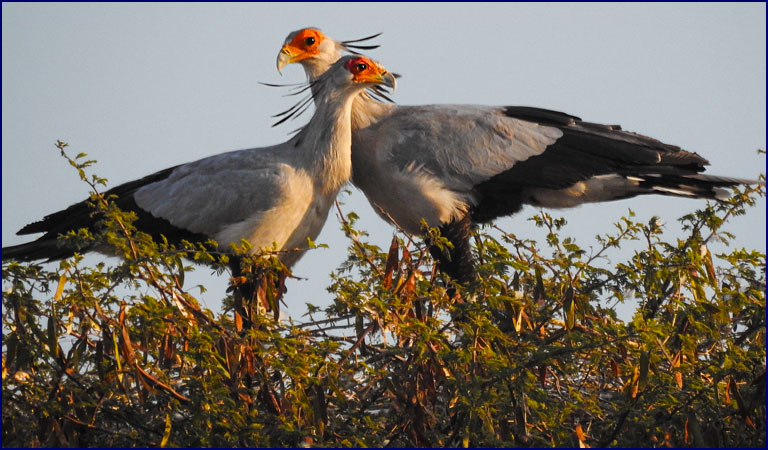|
We sat in the land cruiser, waiting
quietly on the Chobe plain. Before long we saw a lithe tawny form
moving through the brush - a lioness, coming our way. She was
followed by another, and another, weaving through the scrubby
trees in a line. Soon half a dozen lions were quietly walking
across the plain toward us.
I was sure the lions
would see the vehicles waiting and veer away, but amazingly they
took no notice of us. The lead lioness came right to us and sat
down within thirty feet of the land cruiser. One by one the others
joined her. The adult females stood looking around, and the
younger ones flopped down to sleep. Several more lions joined the
party; as the dominant lioness arrived the youngsters got up and
greeted her one by one, rubbing themselves against her
affectionately. Several of the young males were bigger than the
lioness, but it was clear that she was the boss. She scanned the
area for possible prey, pretty much ignoring the youngsters.
All
in all there were nine of them; three adult lionesses, two
adolescent males with scruffy manes, and the rest youngsters. The
dominant male was not with them. The pride seemed quite relaxed,
yet they were also alert. Several of the adults seemed to be
scanning their surroundings, on the lookout for enemies or lunch.
One huntress gazed intently at a warthog that was rooting around
in the bush a good ways off, oblivious to its possible peril. She
started stalking toward it, but after a while she changed her mind
and lay down again. Another lioness gazed wishfully at the ostrich
in the distance.
A
young male lion climbed up on top of a termite mound, surveying
his territory and no doubt dreaming of one day being King of the
Beasts. Several of the others lay down and took a nap. One of the
adolescent males got up and walked straight toward us. As he got
close Gee quietly murmured, ‘Stay still, be quiet, do not
move.’ The lion came right to us, passing close enough to the
open side of our vehicle that I literally could have reached out
and touched him. (I didn’t.) He
met my eye as he passed. He was magnificent - all feline
grace and raw power. It was thrilling beyond measure.
We
watched the lions, enthralled. After a while most of them lay down
to sleep. As the day got warmer they started repositioning
themselves to find shade; they would get up one or two at a time,
yawn and stretch, and move to a new resting spot. Several times
one of them walked within a foot of the land cruiser. Leaning out
taking photos, I accidentally dropped the lens hood from my camera
on the ground beside the vehicle; needless to say I did not get
out and retrieve it.
It amazed me that the lions had
laid down for the day right beside the vehicles. I knew that they
did not fear us – after all, they are at the top of the food
chain. But still, I would have expected the annoyance factor of
having tourists at their resting spot would have compelled them to
go to a more private spot, which they easily could have done since
we were not allowed to go off the road. But Gee explained that the
lions do not recognize us as humans when we are in the vehicle;
they see us and the land cruiser as one big entity, and take no
more notice of us than they would of an elephant browsing nearby.
But if we got out of the vehicle it would be an entirely different
story - the lions would either move away or kill us, depending on
their mood.
Eventually
the lions were all sleeping, and it was time to move on. As we got
ready to leave another safari guide pulled up between us and the
lions, and sheltered between the vehicles a man got out and
retrieved my dropped lens hood. We left the lion pride snoozing,
reflecting on the incredible experience. The Dawson Family has a
tradition of composing ridiculous limericks while on vacation, so
I came up with this one:
The
Lion’s the King of the Beasts
Nothing bothers him in the least.
But when people from far
Get out of the car
On tourists the Lion will feast.
|
Gee
spotted a small group of African wild dogs sleeping in the shade.
These endangered animals are very rare. They were a good ways from
the road, so we watched from a distance as a couple of the dogs
got up and moved to another spot. They were lean like greyhounds,
with big round ears and mottled brown, black and white coats. Near
them was a man in a land rover which had a sign that said Official
Wildlife Photographer; that is what I want to do in my next
life!
We continued down the road,
stopping to watch a small herd of zebras. A beautiful magpie
shrike flew past, black and white with a long tail. Two kudu bulls
looked out at us from the shadows; I think these are the most
beautiful of all the antelopes.
Gee got a report of a possible
leopard sighting near where we had seen the dogs, so we went back
to check it out. From a distance we could see several dogs
sleeping in the shade. We waited, and a leopard came into view,
walking along through the brush. Upon sighting the wild dogs it
quickly changed direction; Gee said a pack of dogs can kill a
leopard, so this one wasn’t taking any chances. Gee drove around
to the other side of the area, and parked where he hoped we might
get a better view.
Sure
enough, the leopard moved toward us. She was a female, very
refined and beautiful. I was struck by how small she was compared
to the lions. Gee seemed to have a knack for knowing where to park
- as the lions had done earlier, she came straight toward us. Gee
softly instructed us to be still, be quiet, and we watched in
silent anticipation as she came nearer. She passed right by our
land cruiser, so close I could have put out my hand and touched
her. Then she paused for a second and turned, allowing us to
admire her feminine beauty. It was magical. She moved off,
climbing a nearby kopje and making a soft trilling sound - Gee
said she was calling for her cubs.
Moving
on, we passed a familiar-looking little blue pickup truck; it was
the Dutch couple we had pushed out of the sand on the road from
Kasane, on their self-drive safari. While exploring on one’s own
is something I love to do in many places, it is not the best way
to see Africa. Without Gee to guide us, we would never have seen
half the wildlife we did.
We came across a large herd of
wildebeest and waterbuck mingled together grazing; Gee said this
was very unusual and he had never seen it before. Several warthogs
scurried around among them, tails held straight up over their
backs. We watched a dozen banded mongooses as they scratched in
the dirt searching for insects, their brown and black stripes
providing camouflage. Roller birds and hornbills were out in
force.
We
got a much closer look at the male ostrich we had seen from a
distance earlier; these enormous flightless birds weigh up to 300
pounds, and are slightly ridiculous looking and unforgettable.
They have strong powerful legs, long skinny necks and tiny heads.
The males are black with white highlights, and the females are a
drab grey color.
|

Male Ostrich |
Further on we saw a group of tsessebe, with dark brown coats, an
athletic uphill build, short horns and intelligent eyes – it was
our first time to see these attractive antelope.
We stopped for a tea break around
ten-thirty. Gee brought out thermoses of hot water to make tea and
coffee, and some cookies and biscotti. Butterflies flitted above
the tall grasses. A swallow-tailed bee-eater perched on a twig,
and a black-chested snake eagle soared above us.
We
drove back beside the river; it was mostly dry, but there were
channels and pools of water along it. The fish eagle was still
there, gazing down regally from a nearby tree as he surveyed his
territory. A pair of elephants meandered down the dry riverbed
toward us. A large flock of white pelicans flew in formation high
in the air, wheeling back and forth in perfect synchronization.
Gee explained that they soar to cool off during the hot part of
the day, catching the high breezes. Mesmerized, we watched them as
they soared in gracefully.
A
pair of saddle-billed storks waded in the shallow water, vibrant
black and white with bills striped with orange and yellow. They
are tall and elegant, with a wingspan of over eight feet. We found
many birds - a few new ones for the list included a Dickenson's
kestrel, a swamp boubou and a wood sandpiper. An immature fish
eagle flew down the river past us.
As we drove along Gee suddenly
exclaimed, ‘Look at the leopard!’ And sure enough, there one
was, curled up in the sand beside the riverbed taking a nap. He
squinted up at us sleepily as we approached, eyes half closed. His
ears were tattered, and he looked tired. Gee crossed the riverbed
and pulled the vehicle up close to him for just a moment, possibly
bending the rules a little. He told us that this was one of the
fish-eating leopards about which a documentary had been made; this
unusual family of leopards survives by regularly catching and
eating fish. We took a few photos, then left him to his slumbers
and continued along the river.
There
was a large colony of marabou storks gathered along the river,
some standing by the water and others perched in a dead tree.
These birds are huge, with wingspans up to nine feet. They have
black backs, white underparts, and a bare head and neck. A large
pink sack hangs from their throats, which when inflated with air
is huge and vaguely obscene-looking. They are considered a member
of the Ugly Five. The most dangerous animals to hunt have become known as
the Big Five; elephants,
lions, leopards, buffalo, and rhinoceros. Less well known are the Ugly Five; wildebeests, vultures, warthogs, hyena and the Marabou
stork.
|

Marabou Stork |
We
returned to the camp about 1:30, and Open was there to greet us
with glasses of ice tea. We were bubbling over with excitement;
this had been the best game drive ever! To see so much in one
morning was amazing. Chobe National Park is known for having one
of the highest concentrations of animals in Africa, and it did not
disappoint.
An excellent lunch was served,
with special dishes for Nick and Rosemary who are vegetarians.
After lunch KP brought warm water to fill the bucket shower in the
canvas enclosure behind our tent. Jineen and I were conservative
with the water as we took turns showering, but there ended up
being plenty, and it felt great to get rid of the travel dust. It
seemed very unusual to be showering beneath the open sky; one
could get a suntan in places that don’t usually see the light of
day!
We had high tea at
3:30 - but we had just eaten lunch! Then we all clambered back in
the land cruiser for the afternoon drive. We went back down along
the river hoping to see the leopard again, but he had moved on. An
elephant was standing in the water, with marabou storks lining the
shore in front of him. We saw a roller bird holding a small
writhing wormlike snake in its beak.
We passed a pile of elephant bones, bleached white by the sun.
Squirrels ran up the trees, and a fish eagle came in for a
landing. The pelicans were again
soaring above, riding the thermals in
perfect synchronization.
We
found giraffes out on the plain. These regal animals are among the
most beautiful in Africa. Red-billed oxpeckers clung to their
necks and heads, picking ticks out of their ears - I felt these
birds should really be called giraffe-peckers. We learned that a
group of giraffes is called a tower
if standing still, and if moving it is known as a journey
of giraffes.
A
black-backed jackal was crossing the plain, and his path brought
him near the road. He was absolutely beautiful, reminding me of a
larger version of a red fox. A pair of ground hornbills ran along
near the road; the patches of bare red skin on their faces could
put them on the list of alternates for the Ugly
Five. A slender mongoose stood up on his hind feet in the
grass and peaked out at us; he was impossibly cute.
|

Slender Mongoose |
Two
secretary birds were perched on top of an acacia tree, courting.
These vulture-sized birds of prey are striking to look at, with
bold black and white plumage and long quills on the back of their
necks. They stood facing each other, preening and rubbing heads.
Sally and Mary also identified a rufous-naped lark and a steppe
buzzard.
|

Secretary Birds |
We
passed through some woods and then came out into the open. Before
us there was a herd of giraffes crossing a golden plain. There
were eight of them walking in a line, striding through the tall
grasses in ground-covering, slow-motion steps. More giraffes came
out of the trees and joined them; soon there were more than a
dozen. We decided to call this spot Giraffic Park.
As
we drove on, we found even more giraffes. We watched a family of
these elegant creatures, with several half-grown babies, as they
strode across the open plain. They
were breathtaking. We had noticed that although the sky was
a deep clear blue, there seemed to be a greyish haze around the
horizon - we were not sure what caused that.
As
the sun was getting low in the sky, we returned to where we had
seen the lions that morning. They were still there, nine of them,
sleeping - apparently they had slept all day without moving, much
like the housecats on my bed at home. Presently several of them
woke up, stretching and yawning. One pair sat side by side gazing
up at the three-quarter moon.
Gee
told us about the lifestyle of the lions. The prides are very
close-knit. The lionesses do the majority of the hunting while the
dominant males defend the territory. The youngsters are dependent
on the adults to hunt for them until they are several years old.
As they grow up the females will stay with the pride, but the
dominant male lion will drive the younger males away as they reach
maturity. These adolescents will join up with other outcast
bachelors and form coalitions, until eventually they are
experienced and strong enough to form their own pride, or fight to
take one over.
We
left the lions and headed back; the park rules required us to be
in camp by 6:30. The afternoon sky gradually filled with subtle
color; a hazy purple at the horizon, blending to shell pink, to
golden, to dusky blue. A hyena loped along in the fading light.
The sun was below the horizon by the time we returned to camp, and
the sky was on fire. There were lanterns on the table and the
campfire was blazing. Across the riverbed a marabou stork perched
high in a dead tree, silhouetted against the magenta sky. The
colors remained long after sunset, before finally fading into the
twilight. It was a magical evening.
We
sat around the fire until Mosa announced dinner. The food was
excellent; it was amazing what delicious meals Mosa could make
cooking in a Dutch oven or over the fire. After dessert we sat
around the fire again, moving in close for warmth. We could hear
the high-pitched whistling call of a pearl-spotted owl from
nearby.
The moon, waxing toward full, was
flooding the dry riverbed with a silvery light. I had been looking
forward to the brilliant African night sky with its unfamiliar
southern constellations, so I was a bit disappointed that the
moonlight obscured the stars. We headed for our tents around ten
o’clock; this time I took a warm heavy blanket from the land
cruiser.
|